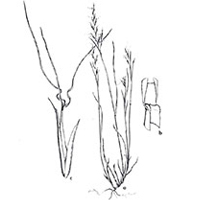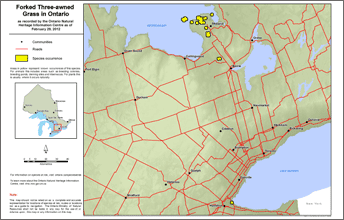Forked three-awned grass
Scientific name: Aristida basiramea

Cover photo credit: R.H. Mohlenbrock
Status
Endangered
“Endangered” means the species lives in the wild in Ontario but is facing imminent extinction or extirpation.
Date added to the Species at Risk in Ontario List
The Forked three-awned grass was already assessed as endangered when the Endangered Species Act took effect in 2008.
What it looks like
Forked Three-awned Grass is an annual plant that grows 30 to 50 centimetres tall. The leaves reach five to 15 centimetres in length, but only about one millimetre in width. Plants branch primarily at the base.
The bristle-like structures that are attached to its lemmas, the lower of the two modified leaves that enclose the flower, are called “awns”, giving the species part of its name. Forked Three-awned Grass is easiest to identify in September and October when the plants are well developed.
Where it lives
Forked Three-awned Grass grows on open, bare ground or in sparsely-covered grassy areas, often in bare spots between patches of other species of grasses.
The maintenance of this type of habitat requires periodic disturbances, such as fire or drought, to prevent other plants from dominating the area.
However, some forms of disturbance facilitate the establishment of invasive plant species that can outcompete Forked Three-awned Grass.
Where it’s been found in Ontario
Forked Three-awned Grass is found primarily in the Midwestern United States, west from Colorado, south to Texas, east to Maine, and north to central Minnesota, northern Wisconsin and northern Michigan.
In Canada, Forked Three-awned Grass is found only in southwestern Quebec and southern Ontario, with one likely introduced population found in the Rainy River area of northwestern Ontario.
View a Larger version of this map (PDF)
What threatens it
The main threat to Forked Three-awned Grass in Ontario is habitat loss and degradation.
This occurs from development and fire suppression, which allows competing plants to flourish, including tree planting and the introduction of invasive plant species.
Action we are taking
Endangered Species and their general habitat are automatically protected
Recovery strategy
A recovery strategy advises the ministry on ways to ensure healthy numbers of the species return to Ontario.
Read the executive summary (February 18, 2011)
Read the recovery strategy (February 18, 2011)
Government response statement
A government response statement outlines the actions the government intends to take or support to help recover the species.
Read the government response statement (November 18, 2011)
Five-Year Review of Progress
A five-year review reports on progress made toward protecting and recovering a species, within five years of publishing a species’ government response statement.
Read the report on progress towards the protection and recovery of 27 species at risk, including Forked Three-awned Grass (2016)
Habitat protection
General Habitat Protection - June 30, 2013
What you can do
Report a sighting
- Report a sighting of an endangered animal or plant to the Natural Heritage Information Centre. Photographs with specific locations or mapping coordinates are always helpful.
Volunteer
- Volunteer with your local nature club or provincial park to participate in surveys or stewardship work focused on species at risk.
Be a good steward
- Private land owners have a very important role to play in species recovery. If you find Forked three-awned grass on your land, you may be eligible for stewardship programs that support the protection and recovery of species at risk and their habitats.
- Invasive species seriously threaten many of Ontario’s species at risk. To learn what you can do to help reduce the threat of invasive species, visit:
www.ontario.ca/invasivespecies
www.invadingspecies.com
www.ontarioinvasiveplants.ca
Report illegal activity
- Report any illegal activity related to plants and wildlife to
1-877-TIP-SMNR (847-7667) .
Quick facts
- Seven populations of this plant were discovered by superimposing maps of shoreline bluffs from the end of the last ice age onto modern satellite imagery and then surveying rough, open fields, where these ancient shorelines once existed.
- Since Forked Three-awned Grass is an annual, its growth and reproduction are influenced by each year’s environmental conditions. This makes estimating population size difficult, as a number of plants present in an area may remain relatively undetectable in the soil seed bank during any given year.
- Most of the 250 to 300 members of this plant’s genus, Aristida, are found in warm-temperate to tropical climates.
